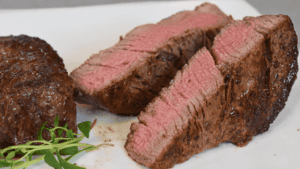Omelette
An omelette is made by beating eggs and cooking them in a pan until set. You can add fillings like vegetables, cheese, meat, or herbs before folding it over to serve. There are various styles, including French, Spanish, and American.

How to Make the Perfect Omelette
Start your day with a fluffy, flavorful omelette that energizes you. Many home cooks find this dish challenging, but with the right technique and quality ingredients, you’ll master it in no time.
Introduction
An omelette isn’t just about eggs—it’s a blank canvas for your culinary creativity. Once you master this dish, you’ll have a quick, nutritious meal option at your fingertips. While simple, the right technique and ingredients are crucial.
Step 1: Gather Ingredients and Tools
Begin your omelette-making adventure by gathering fresh ingredients and essential tools:
Ingredients:
- 4 large eggs
- 1 tbsp butter
- ¼ small onion, chopped
- ¼ green bell pepper, chopped
- ¼ red bell pepper, chopped
- ½ cup minced ham
- ½ cup shredded cheese
Tools:
Step 2: Prepare the Eggs
Crack the eggs into a bowl and whisk until the yolks and whites blend into a uniform color. Add a pinch of salt and pepper to enhance their natural flavors.
Step 3: Choose and Prepare Fillings
The beauty of an omelette is its versatility. For this recipe, we’re using onions, bell peppers, and ham. Prepare these ingredients in advance and cook them lightly, as they’ll finish cooking with the eggs.
Step 4: Cook the Omelette
Melt butter in a heated pan, pour in the eggs, and let them set slightly on the edges. Gently push the edges towards the center, tilting the pan to allow uncooked eggs to flow to the edge. Once the eggs are partially set, add your fillings to one side and sprinkle cheese generously. Fold the other half over and cook through.
Step 5: Serve and Enjoy
Slide your omelette onto a plate. Garnish with fresh herbs, serve with crisp toast, or add ripe tomatoes for extra flavor and texture.
Tips for a Perfect Omelette
- Use room temperature eggs for better consistency and easier whisking.
- Avoid overbeating the eggs to keep them light and fluffy.
- For creaminess, replace some whole eggs with egg whites.
- Thoroughly cook raw meat or vegetables before adding them.
- Add a touch of sweetness with honey or sugar to the egg mixture.
- Experiment with different cheeses for unique flavors.
- Use olive oil instead of butter for a healthier option.
- Try non-breakfast fillings like leftovers for savory omelettes.
- Cook on medium heat patiently for an even color.
- Practice makes perfect; refine techniques and fillings over time.
Expanding Your Breakfast Menu
A collection of reliable breakfast dishes is always a delight. Here are some favorites to inspire you:
- Delicious Breakfast Skillet in 15 Minutes – This flavorful and nutritious meal combines diced potatoes, sausage, eggs, green onion, cheddar cheese, and green and red bell pepper. It is sure to delight your taste buds while providing a healthy and satisfying dining experience.
- Corned Beef Hash – A classic dish made of potatoes, onions, and corned beef. It can be cooked in many different ways, but using canned corned beef is one of the quickest methods.
- Peanut Butter & Jelly Sandwich – The peanut butter and jelly sandwich, also known as the PB&J, is one of the most popular sandwich varieties in America. The classic version consists of two slices of bread with a layer of peanut butter spread on one side and a layer of jelly (typically grape) spread on the other.
- Fluffy Pancakes – A breakfast favorite that has been around for centuries! Traditionally, pancakes were made from a batter of eggs, milk, and flour. The addition of baking powder and other ingredients makes them light and fluffy.
- Cheese Omelette – A type of dish made by beating eggs and cooking them in a pan with cheese, often folded over to form a half-moon shape. It is typically served for breakfast or brunch and may include additional ingredients such as vegetables, meats, or herbs.
Frequently Asked Questions
What’s the key to a great omelette?
Use high heat and cook quickly to avoid tough eggs. Fresh ingredients, well-beaten eggs, and adding salt just before cooking are crucial.
What fillings work best in an omelette?
Popular choices include cheese, vegetables, meats, and herbs like chives and parsley.
Should you add milk or water to an omelette?
Both are used worldwide, but moderation is key—a tablespoon per egg is enough.
How do restaurants make omelettes so fluffy?
Techniques include adding air to the egg mixture, using quality pans, and cooking on high heat.
Is there a secret ingredient for fluffiness?
Some chefs add a pinch of cornstarch or baking powder.
Why add water to scrambled eggs?
Water creates steam for a fluffier texture, unlike milk, which can make eggs heavy and watery.

Omelette
Ingredients
- 1 tbsp butter
- ¼ small onion chopped
- ¼ small green bell pepper chopped
- ¼ small red bell pepper chopped
- ½ cup minced ham
- 4 large eggs
- ½ cup shredded cheese
Instructions
- Whisk the eggs and finely chop the onion, green bell pepper, and red bell pepper.
- In a medium non-stick skillet, melt butter over medium heat. Add the onion, green bell pepper, red bell pepper, and ham. Cook for 5 minutes, then set aside.
- In a separate small non-stick skillet, melt butter over low heat. Pour in the beaten eggs and cook for 2 minutes. Add the filling on one side of the omelette and sprinkle with cheese. Cover and cook for an additional 3 minutes.
- Fold the omelette in half and transfer it onto a plate. It's ready to be served.














